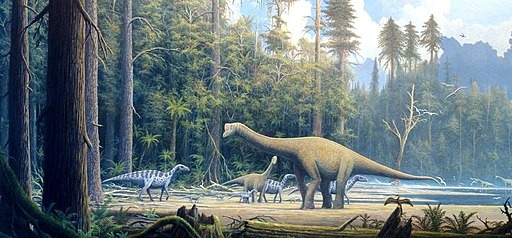In the search for exoplanets with potentially habitable environments, astronomers rely on Earth as an example of what to look for. Experts believe that the presence of nitrogen, oxygen, and other trace gases makes our atmosphere capable of supporting life. So when they look for a "second Earth," they try to find the same combination of elements.

However, a new study from Cornell University reveals that the modern Earth may not be the best model for finding habitable planets. It suggests going back to the Mesozoic era, where high oxygen concentrations gave rise to the age of dinosaurs.
Life During the Mesozoic Era
The Mesozoic Era is the second of the three major geologic eras of Phanerozoic time. Its name is derived from the Greek word which means "middle life." It has three major divisions, namely the Triassic Period, the Jurassic Period, and the Cretaceous Period.
This era is best known as the time of the dinosaurs, but this is also when the ancestors of major plants and animals that we have today first appeared. It is also characterized by a generally warm climate with less difference in temperature between equatorial and polar latitudes than today.
The Mesozoic era was also a time of geologic and biological transition. During this time, the continents began to move into their present-day locations. Modernization of life forms also occurred, partly due to the demise of many earlier organisms.
Search for a New Home
The research team analyzed the most recent 540 million years of Earth's evolution, known as the Phanerozoic Eon. Estimates from two established climate models (GEOCARB and COPSE) were used in simulating the atmospheric composition of the Earth and the transmission spectra over five 100-million-year increments of the Phanerozoic. Each increment features crucial changes, such as the diversification of the complex ocean biosphere, which influences the mix of oxygen and other gases in the atmosphere.
Models of Earth around 100 to 300 million years ago showed a stronger presence of key biosignature pairs - oxygen and methane and ozone and methane. The models simulated the transmission spectra, or light fingerprints, generated by an atmosphere that absorbs some colors of starlight. This is the information used by scientists in determining the composition of the atmosphere.
According to Carl Sagan Institute (CSI) director Lisa Kaltenegger, the light fingerprint of modern Earth has been the template for identifying potentially habitable worlds. However, there was a time when this fingerprint was even more pronounced and was better at showing signs of life. This gives hope that it could be easier to find signs of life anywhere in the cosmos.
They found that telescopes could better detect chemical signatures of life in the atmosphere of exoplanets that closely resemble the age of dinosaurs. This era is only 12% of Earth's history, yet it encompasses much of the time when life was more complex than sponges. As described by research first author Rebecca Payne, these light fingerprints should be the ones to look for when searching for something more advanced than a single-celled organism.
Similar evolutionary processes may or may not unfold on other planets, but Payne and Kaltenegger believe their models fill in a missing puzzle piece of what a Phanerozoic world would look like to a telescope. They hope this can create new templates for habitable planets with varying atmospheric oxygen levels.
RELATED ARTICLE: Newfound Exoplanet Could Shed New Information on How Earth-like Planets Evolve
Check out more news and information on Exoplanet in Science Times.














